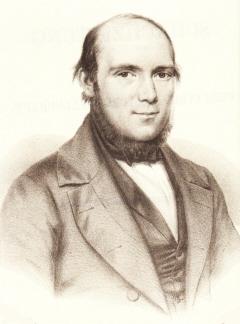
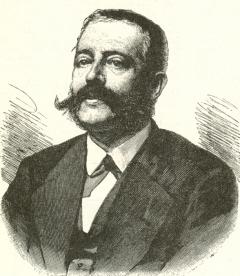
Edward Winter


Adolf Anderssen and Jean Dufresne
Fabrizio Zavatarelli (Milan, Italy) raises an interesting point regarding the ‘Evergreen Game’ between Anderssen and Dufresne. Any number of books state that it was played in Berlin (in 1852) – see, for instance, our comment in Historical Havoc – but can it be proved that Berlin was indeed the venue? Our correspondent writes:
‘As far as I know, the earliest source of the game is Deutsche Schachzeitung, September 1852, pages 338-339, and October 1852, page 383. The game was then picked up in the Chess Player’s Chronicle of 1853, pages 4-11; in none of these cases was the venue indicated.
No occasion at all was specified in the following books by Dufresne:
- Philidoria (Berlin, 1871), page 61;
- Grosses Schach-Handbuch by Dufresne and Zukertort (Berlin, 1873), page 314;
- Kleines Lehrbuch des Schachspiels (sixth edition, 1892), page 98.
In Der praktische Schachmeister (Hamburg, 1865) even the names of the players are absent, and the game does not appear in Theoretisch-praktisches Handbuch des Schachspiels (Berlin, 1863) or Schachfibel (Styrum and Leipzig, 1888).
Even Hermann von Gottschall’s Adolf Anderssen (Leipzig, 1912) gives only the names of the players, without any place or date. See page 110.
So what is the exact reason for Berlin being known as the venue of the Evergreen Game? Is it definite that the game was not played in, for instance, Breslau?’
We note that on page 19 of the monograph A. Anderssen 151 partier by L. Collijn (Stockholm, 1918) the game was headed ‘Berlin, 1852’, but what precisely can be found in nineteenth-century sources? An article entitled ‘Reminiscences of German Chess’ by Jean Dufresne was published on pages 1-6 of Brentano’s Chess Monthly, June 1882. It contained much of interest regarding his encounters with Anderssen, although no direct evidence about the Evergreen Game.
For the time being, we merely offer a miscellany of general jottings on the game, and readers are invited to supplement them.
On pages 19-20 of Cartilla de Ajedrez by J.R. Capablanca (Havana, 1913) both Anderssen v Kieseritzky and Anderssen v Dufresne were given with brief notes and were respectively labelled ‘La inmortal’ and ‘La otra inmortal’. Capablanca’s note after 24 Bxe7 mate was, ‘Este final es una joya imperecedera’. Both games were also published on pages 72-74 of the November 1891 Chess Monthly, introduced thus:
‘The following two games are most remarkable for brilliancy, and have been accepted by universal consent as “The immortal games”.’
Anderssen v Dufresne was undated, but the venue was given as Berlin.
In item 171 of unit two of Napier’s Amenities and Background of Chess-Play (New York, 1934) W.E. Napier described 19 Rad1 as ‘A move in a billion’.
The game appeared on pages 19-20 of Chess Sparks by J.H. Ellis (London, 1895), headed ‘Played in Berlin in 1853’. And from page 147 of A History of Chess by Harry Golombek (London, 1976):
‘... a famous game with a combination of rare beauty which he [Anderssen] played against Dufresne in 1853. Anderssen won, and the game has borne the title ever since of the “Evergreen”.’
The date 1853 was also given in both editions of Anne Sunnucks’ Encyclopaedia of Chess but is, of course, incorrect (the game having been published by the Deutsche Schachzeitung in 1852).
The concluding play was discussed on pages 24-26 of the November 1907 issue of Lasker’s Chess Magazine, in an item by Lasker reproduced from the New York Evening Post, 6 November 1907, page 7. The introductory paragraph was:
‘One of the most famous combinations is that which occurred, some 50 years ago, in an offhand game between Anderssen and Dufresne in Berlin.’
Lasker also examined the combination in his Manual. Moreover, he gave the full game on pages 43-45 of Common Sense in Chess (London, 1896). The heading:
‘One of the finest games on record was played at a time when the analysis of the Evans Gambit was not yet far advanced. It has been named “the evergreen partie”. The leader of the White forces was Professor Anderssen.’
Dufresne was not identified. Nor was he on page 91 of James Mason’s Social Chess (London, 1900), which merely stated that the contest, ‘Known as “The Evergreen Game”’, was ‘won by Anderssen’. However, Dufresne was mentioned when the finish to the game appeared on page 218 of Mason’s The Art of Chess (London, 1895), but the word ‘evergreen’ was not there.
The word was used in general terms about Anderssen (and Cochrane) on page 227 of the Chess World, 1866:
‘There is about both of them an overflowing richness; the character of their play is evergreen.’
As regards the origins of the ‘evergreen’ label for Anderssen v Dufresne, Irving Chernev wrote on page 549 of 1000 Best Short Games of Chess (New York, 1955):
‘Steinitz in poetic mood called this game “the blossom in Anderssen’s wreath of laurel” and named it “the evergreen partie”.’
The same text was attributed to Steinitz by Chernev on page 230 of The Chess Companion (New York, 1968).
But when was the description ‘Evergreen’ first used? And, in particular, was it ever seen during Anderssen’s lifetime? In The Field of 29 March 1879 Steinitz paid tribute to the late master by annotating his two celebrated games against Kieseritzky and Dufresne. Both sets of detailed notes were reproduced on pages 102-105 of the 1 May 1879 issue of the Chess Player’s Chronicle, and below we give Anderssen v Dufresne:
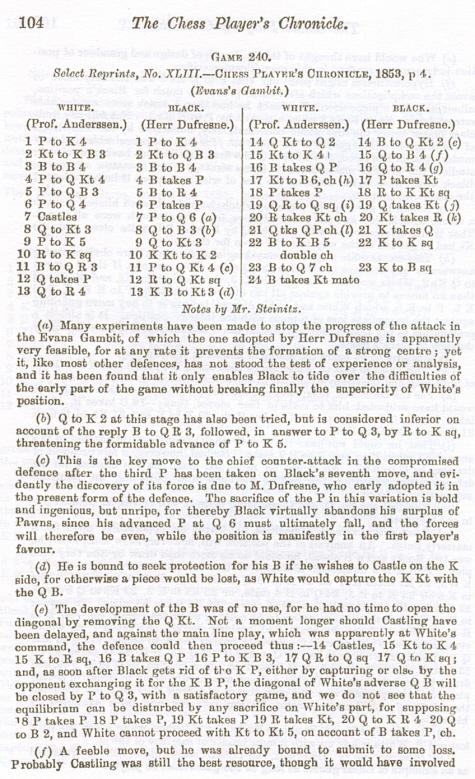
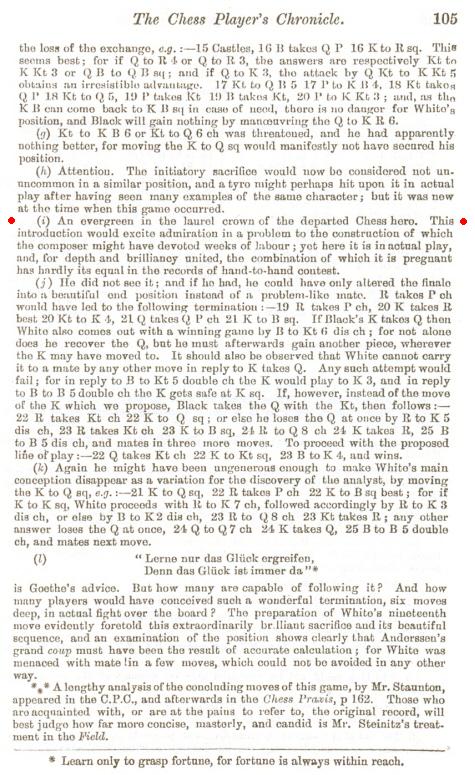
As marked, Steinitz’s note to 19 Rad1 began:
‘An evergreen in the laurel crown of the departed Chess hero.’
On page 72 of the March 1885 International Chess Magazine Steinitz simply referred to:
‘...Anderssen’s immortal game with Kieseritzky, and his no less famous Evans Gambit against Dufresne ...’
On the other hand, page 147 of Dictionary of Modern Chess by Byrne J. Horton (New York, 1959) affirmed:
‘Steinitz spoke of the “Immergrün Partie” meaning the “Evergreen game” ...’
What more can be found in Steinitz’s writings? In particular, what details can be traced further to Chernev’s statement that Steinitz used the specific term ‘evergreen partie’?
See too pages 157-158 of The Steinitz Papers by Kurt Landsberger (Jefferson, 2002).
B.H. Wood discussed the game on page 86 of the Illustrated London News, 12 July 1958, referring to analysis of the game by K.H. Titel in the April 1958 issue of Schach-Echo and adding:
‘Since then a squad of readers of this magazine, crunching away week by week at the position to which dear old Anderssen probably devoted about 20 minutes, have finally established that the old man was all right after all.’
At the time the Evergreen game was played, Anderssen was in his early 30s.
As reported in Cuttings:
Regarding the Evergreen Game, the following is on page 136 of Pocket Book of Chess by Raymond Keene (London, 1988):
‘Anderssen’s opponent, Jean Dufresne, was actually a German player and writer whose real name was E.S. Freund.’
Jean Dufresne’s real name was Jean Dufresne. E.S. Freund was his pseudonym.

See too C.N.s 10155 and 11126. The full text of the latter item
is reproduced below:
Olimpiu G. Urcan (Singapore) draws our attention to his review of the e-book Carlsen v Caruana: FIDE World Chess Championship, London 2018 by Raymond Keene and Byron Jacobs (London, 2018) and sends us half a dozen lines from the book’s ‘History of the World Championship’ section:
We offer a few comments:
- Anderssen’s opponent in the Immortal Game ‘of London 1851’ was Kieseritzky, a name which Raymond Keene has persisted in misspelling for decades.
- The Evergreen Game was not ‘against the pseudonymous Dufresne (in reality the German player E.S. Freund)’. Dufresne was his name, and E.S. Freund was his pseudonym. Raymond Keene made the same obvious gaffe 30 years ago, on page 136 of his Pocket Book of Chess (London, 1988), as pointed out in C.N. 10155. See too Cuttings.
- Anderssen v Dufresne was not played in 1856. Our feature article on the game shows that it was published on pages 338-339 of the September 1852 Deutsche Schachzeitung.
- Anderssen v Zukertort was played in Barmen, not Breslau.
Even without primary sources, a quick glance at, for instance, The Oxford Companion to Chess by D. Hooper and K. Whyld (Oxford, 1992) would have sufficed to avoid all these elementary blunders.
Now we quote from Raymond Keene’s Article dated 30 July 2022:
‘Anderssen can claim to be one of the supreme tacticians of all time. Three of his wins are of imperishable beauty. On their own they would justify anyone’s devotion to chess. They are his Immortal Game against Kieseritsky (played at Simpsons-in-the-Strand, not the tournament) of London, 1851; his Evergreen game against the pseudonymous Dufresne (in reality the German player E.S. Freund) of Berlin 1856, and his majestic sacrificial masterpiece against Zukertort of Breslau, 1869.’
(11910)
The heading on page 139 of Chess and the Art of War by Al Lawrence and Elshan Moradiabadi (London, 2016):

(9801)
An inscription by Al Horowitz in one of our copies of his book How to Win in the Middle Game of Chess (New York, 1955):
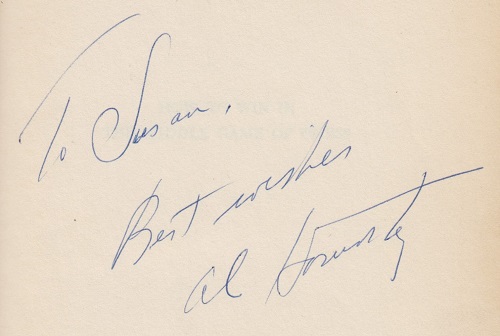
From pages 45-46:
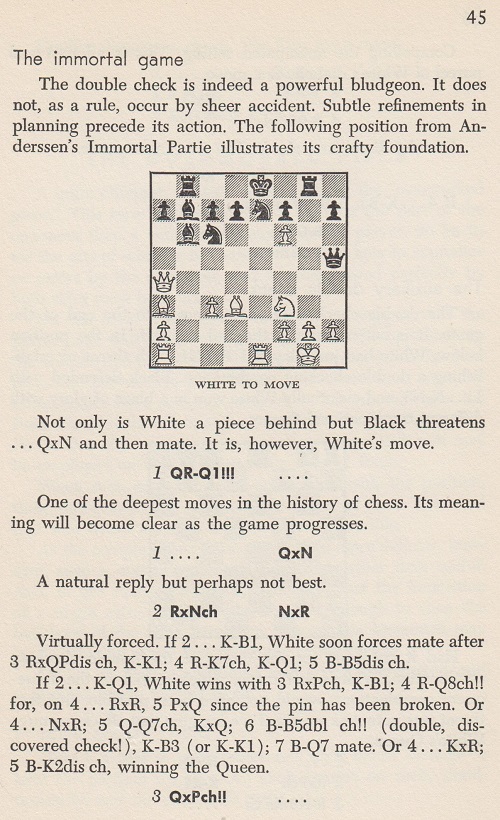
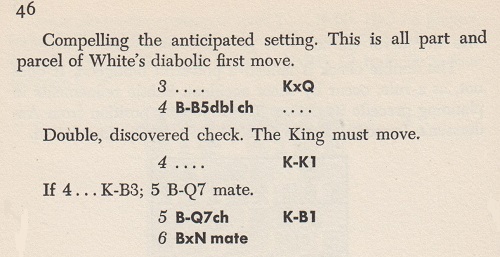
On page 202 of the July 1953 Chess Review Horowitz had given the same material, also mistitled ‘The Immortal Game’.
(10566)
A reply by D.J. Morgan to a correspondent, L. Jarvis, in his Quotes and Queries column on page 33 of the January 1955 BCM:
‘We all know the old “Evergreen” game. The one you quote might well be called the “Nevergreen”.’
The Immortal Game and the Evergreen Game were annotated on pages
82-84 of Emanuel Lasker’s London Chess Fortnightly, 14
January 1893.
Regarding the Evergreen Game, see too the article by Paul Lipke ‘Ein
Blick in die Tiefen Anderssen’cher Combinationen’
in the Deutsche Schachzeitung, May 1898 (pages 129-134)
and June 1898 (pages 161-163).
To the Chess Notes main page.
To the Archives for other feature articles.
Copyright: Edward Winter. All rights reserved.